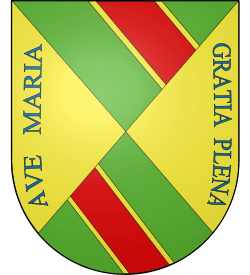Gregorio María de Silva y Mendoza, 9th Duke of the Infantado

Gregorio de Silva y Mendoza (born 1649, Pastrana - d. 1693, Madrid) was a Spanish noble from the House of Mendoza. He was the 5th Duke of Pastrana 9th Duke of the Infantado, 7th Duke of Lerma, 6th Duke of Francavilla, 5th Duke of Estremera, and the Prince of Eboli and Melito.[1]
Family Origins
He was the son of Rodrigo de Silva Mendoza y Guzmán, the 4th Duke of Pastrana and his wife, Catalina Gómez de Sandoval y Mendoza, the 8th Duchess of the Infantado.[2] The Mendoza family rose to power when it merged with the House of Lasso de la Vega through the marriage of Leonor Lasso de la Vega, the last direct member of that line, and Admiral Diego Hurtado de Mendoza, the admiral of Castile.
Biography

He inherited his noble titles after the deaths of his mother and father respectively. In 1679, he was sent to Paris with his brothers Gaspar and José to take the newly crowned Queen Marie Louise of Orléans her bridal gifts which consisted of a painting by Juan Carreño de Miranda of Charles II of Spain. The painting's frame was embedded with diamonds.[3] The group left Madrid on the 30th of July, 1679 and arrived in the French Court on the 14th of September. The ostentatious gift was met with great happiness as is recounted in a contemporary Spanish recording from the day which refers to the Queen, Elisabeth of France's surprise.
"Assi logro el Señor Duque de Pastrana muy cumplidamente el avivar en la corte de Francia la memoria (que siempre vivirá en ella) de su Grande y Generoso Abuelo[4] que fue con el propio carácter, por nuestra inmortal Reyna D.Isabel[5] y se porto con el inimitable lucimiento que ahora su dignissimo Nieto"[6]
The following day, he delivered the present to Mari Louise, an occasion that brought about banquets and parties throughout Paris. In 1686, following the death of his mother, he became the 9th Duke of the Infantado. This officially united all of the family titles held under one name. In 1688, he was named Sumiller de Corps of Charles II of Spain, who in 1693, just before his death, named Gregorio as a Knight of the Order of the Golden Fleece where after he took a leading role in the royal court.[7]
He was also an art enthusiast, especially favoring the painter Juan Carreño de Miranda who painted the picture of Queen Marie Louise. Miranda immortalized Gregorio for his patronage in his famous painting which hangs in the Museo del Prado (see right).[8]
Marriage and Descendants
In 1666, Gregorio married Doña María de Haro y Guzmán (1644 – 1693), daughter of Luis Méndez de Haro, the first minister of Philip IV of Spain and Catalina Fernández de Córdoba y Aragón From this marriage, one son was born:[9]
- Juan de Dios de Silva y Mendoza y Haro (b. November 13, 1672 - d. December 9, 1773) 10th Duke of the Infantado, 8th Duke of Lerma, 6th Duke of Pastrana, etc.
| Preceded by Catalina Gómez de Sandoval y Mendoza |
Duke of the Infantado 1686–1693 |
Succeeded by Juan de Dios de Silva y Mendoza y Haro |
References
- ↑ Grandes de España
- ↑ Gregorio de Silva y Mendoza. Fundación Casa Ducal de Medinaceli
- ↑ La entrada en la Corte de María Luisa de Orleans. Arte y Fiesta en el Madrid de Carlos II. Zapata Fernández de la Hoz, Teresa ISBN 84-930030-5-0 pag.37
- ↑ Se refiere a Rui Gómez de Silva Mendoza y la Cerda, III Duque de Pastrana
- ↑ Se refiere a la reina Isabel de Borbón, primera esposa del rey Felipe IV
- ↑ La entrada en la Corte de María Luisa de Orleans. Arte y Fiesta en el Madrid de Carlos II. Zapata Fernández de la Hoz, Teresa ISBN 84-930030-5-0 pag.39
- ↑ CHEVALIERS DE LA TOISON D'OR
- ↑ "Duque de Pastrana". Retrieved 2009. Check date values in:
|access-date=(help) - ↑ "María de Haro y Guzmán - Fundación Casa Ducal de Medinaceli". Retrieved 2009. Check date values in:
|access-date=(help)